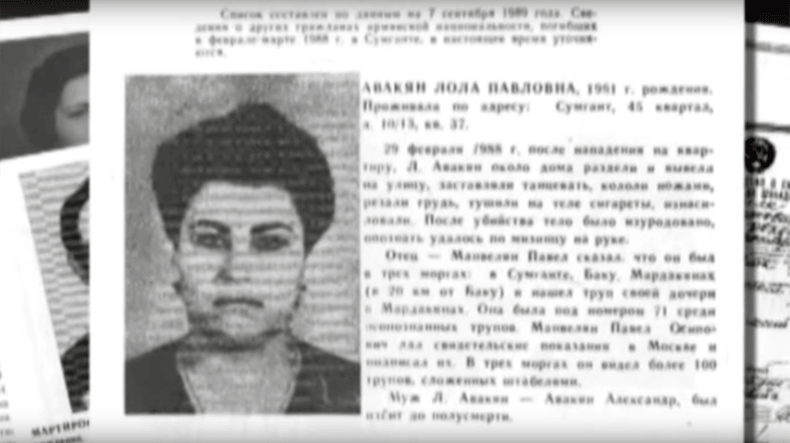
Pogroms of Armenians in Baku in January 1990 were final phase of bloody ethnic cleansing in Azerbaijan, professor says
An overt political, economic, and cultural discrimination was carried out against the Nagorno-Karabakh Autonomous Oblast, which was part of the Azerbaijan SSR, professor of Yerevan State University, PhD in political science Alexander Manasyan told Lithuanian Russian language radio LRT noting that Karabakh conflict was not accidentally chosen as the “detonator of the USSR collapse.”
According to him, the Azerbaijani authorities carried out a politics of internal colonization of Karabakh and the Armenian nation.
“That politics was aimed at the displacement of the Armenians (in Artsakh), who had lived there for centuries and formed, kept, and constantly protected a national sovereignty in various forms of independent and partly independent state entities in that impregnable part of Armenia. The displacement of the Armenians from a place, where they had lived for centuries being the creators of the Eastern Transcaucasia’s political, economic, and cultural history, was obvious and was going on without the Center’s resistance. Karabakh’s population was ready to raise the question in a civilized manner and was receiving massages from the Center saying that ‘their concerns had been raised in the Kremlin.’ Thus, Nagorno-Karabakh was not accidentally chosen for the start of political turmoil in other regions of the Soviet Union,” professor Manasyan highlighted.
Moreover, the scientist noted that the specialists familiar with the region had not difficulty to predict Baku’s reaction to the Artsakh Armenians’ desire to rejoin Armenia.
“The pogroms of the Armenians in Baku in January 1990 were the last phase of a bloody ethnic cleansing. The Soviet troops thrown in the region in the days of the bloody January did not enter Baku. The Center not only did not prevent the pogroms, it did not even interfere with the events, though the troops were in the area of Bin airport waiting for an order. On January 20, when there was no Armenian left alive in the city, the troops proceeded to the city. At that time, Azerbaijan’s Popular Front having ended with the pogroms of the Armenians decided to resist. The troops had to enter the city by means of breaking the resistance,” the professor said.
According to him, after a long period of time, Baku prefers to keep silence on the first days of January. “The thing is that they want to throw shadow on ‘the bloody January’ in such a way. This is the truth. Thousands of people, who managed to be saved, currently live outside their historical places of residence (Kura river’s right and left banks, Northern Artsakh), however, they can give evidence about how everything happened,” Manasyan added.
There are many eyewitnesses to the cruel massacre of the Armenians. Manasyan said that recently, the Armenian community of Saint Petersburg has collected materials of eyewitnesses to the events and published them on the Internet.
At the same time, the professor highlighted that the Azerbaijani authorities want to present the events of January 20, 1990, as a “protest against the USSR,” like many post-Soviet republics did.
“I do not think that the nations that were fighting for sovereignty in the years of the Soviet Union did it by means of other people’s genocide. It is necessary for the political scientists, politicians, and media representatives to always take into account that implication, when they speak about those events,” professor Manasyan emphasized.
This year, the 27th anniversary of the pogroms of the Armenians in Baku has been commemorated. A mass pogrom of Armenian population was committed in Baku from 13 to 19 January 1990 as a culmination of the genocide of the Armenians in Azerbaijan unfolded between 1988 and 1990. After the Sumgait pogroms (26-29 February 1988), persecutions, beatings, particularly cruel killings, public mockeries, pogroms of separate flats, seizure of property, forcible expulsions and illegal dismissals of Armenians started in Baku. Only some 35 or 40 thousand Armenians of the community of 250 thousand remained in Baku by January 1990; they were mainly disabled people, old and sick people and the relatives looking after them. The pogroms took an organised, targeted and mass nature since 13 January 1990. A large amount of evidence exists about the atrocities and killings committed with exceptional cruelty, including gang rapes, burnings of people alive, throwing people out of balconies of higher floors, dismemberments and beheadings.
The exact number of the victims of the genocide of the Armenians in Baku still remains unknown. According to different sources, between 150 and 400 people were murdered, and hundreds were left disabled. The pogroms went on for a week amid a total inaction of the authorities of Azerbaijan and the USSR, as well as the internal troops and the large Baku garrison of the Soviet Army. Those who managed to avoid death were forced into deportation. The Soviet troops were deployed to set order in Baku only on 20 January 1990.
For more detail, visit KarabakhRecords
Website KarabakhRecords is created in the frameworks of the project “Ordinary Genocide” which is being implemented by the Public Relations and Information Center of the RA President’s administration and is telling about the events that took place in 1987-1992s, in Azerbaijan and Nagorno-Karabakh.
This resource is aimed at cataloguing documentary base of the project “Ordinary Genocide”, that includes archival documents, photographs and video footages, testimonies of victims and witnesses, material of litigations and criminal cases, reports and assessments by international organizations and experts, publications in mass media.
Newsfeed
Videos






























